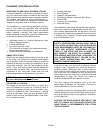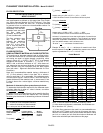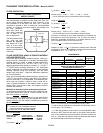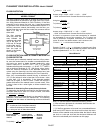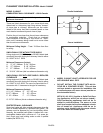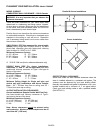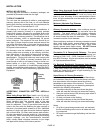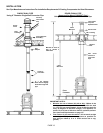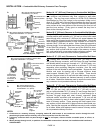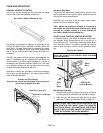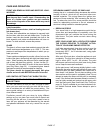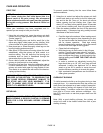
INSTALLATION
PAGE 12
DRAFT REQUIREMENTS
The appliance is merely one component of a larger
system. The other equally important component is the
venting system which is necessary for achieving the
required flow of combustion air to the fire chamber and
for safely removing unwanted combustion byproducts
from the appliance. If the venting system's design does
not promote these ends, the system may not function
properly. Poorly functioning venting systems may cre-
ate performance problems (i.e. smoking stove, poor
heat output, fire goes out, window blackens, increased
creosote buildup, etc.) as well as be a safety hazard.
Some factors that may lead to performance problems
are as follows:
• Oversized or undersized chimney.
• Excessive offsets in venting.
• Insufficient vertical height of chimney.
• Insufficient chimney termination height in relation-
ship to roof.
• Insufficient ventilation.
• Lack of maintenance.
• Improper operation.
• Burning improper fuel (unit is approved for use with
natural dry well-seasoned wood only).
• Down drafts in the chimney (may need a special wind
cap).
To ensure that the venting system is functioning prop-
erly a draft test should be performed (see Draft Test
Procedure on this page).
American National Standards Institute ANSI/NFPA
211-96: A chimney or vent shall be so designed and
constructed to develop a flow sufficient to completely
remove all flue and vent gases to the outside atmos-
phere. The venting system shall satisfy the draft re-
quirements of the connected appliance in accordance
with the manufacturer instructions.
DRAFT TEST PROCEDURE
After this appliance is installed a draft test should be
performed to ensure proper draft. A qualified techni-
cian should perform the draft test procedure as follows:
1) Close all windows and doors in the dwelling.
2) Turn on or operate all appliances which remove air
from the home (such as a furnace, heat pump, air
conditioner, clothes dryer, exhaust fans, fireplaces,
and other fuel burning appliances).
3) Drill a hole in the vent pipe per the draft gauge manu-
facturers instructions (to create a draft test port). Note:
Hole location should be a minimum of 1 foot above flue
outlet collar.
4) Start a fire (See How To Start And Maintain A Fire on
page 16).
5) After the fire is well established (20-25 minutes) and
burning at a low setting, perform the draft test per the
gauge manufacturer instructions. The draft gauge
should read between .05 and .06” W.C. (inches water col-
umn). Excessive draft (above .06 W.C.I.) can result in too
much combustion air to be pulled into the firebox, this will
produce hotter burns and could result in overfiring. Too lit-
tle draft (below .05” W.C.) will not allow enough combus-
tion air delivery to maintain a fire well or cause perform-
ance problems such as smoking (this may result in im-
proper operation of appliance, i.e. will not maintain fire well
unless ash drawer or fuel door is left open).
6) Install a screw to seal the draft test port in the vent pipe. If
the draft test reading was not within the required range,
correct the installation and repeat this procedure.
VENTILATION REQUIREMENTS / PROVIDE ADEQUATE
AIR FOR COMBUSTION
THE FRESH AIR REQUIREMENTS OF THIS APPLI-
ANCE MUST BE MET WITHIN THE SPACE WHERE IT
WILL BE INSTALLED. VENTILATION IS ESSENTIAL
WHEN USING A SOLID FUEL BURNING HEATER.
In well insulated and weather tight homes, it may be diffi-
cult to establish a good draft up the chimney (caused by a
shortage of air in the home). The lack of air is caused by
many common household appliances which exhaust air
from the home (such as a furnace, heat pump, air condi-
tioner, clothes dryer, exhaust fans, fireplaces, and other
fuel burning appliances). Also, the combustion process of
this heater uses oxygen from inside the dwelling. If the
available fresh air delivery in the dwelling is insufficient to
support the demands of these appliances, problems can
result (i.e. excessive negative pressure can develop in the
dwelling which will affect the rate at which this appliance
can draft thus resulting in performance problems; See
Draft Requirements on this page). To correct this problem
it may help to open a window (preferably on the windward
side of the house) or install a vent to provide make-up air
into the dwelling.



